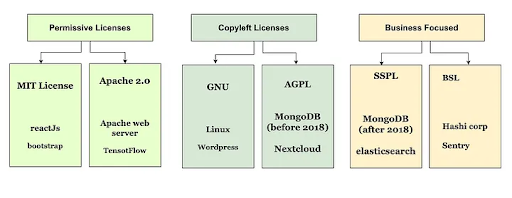
When you're developing a project on GitHub, choosing the right open-source license is crucial. With just a few clicks, you can add a license to your repository, whether it's the permissive MIT license, the Apache license, or something else. But what are the different categories of open-source licenses, and why should you care about them? Let's dive into the details.
Why Should You Use an Open-Source License?
- Legal Protection: Without a license, others can copy, modify, and even sell your software without giving you credit. Open-source licenses help protect your intellectual property.
- Community and Contributions: By choosing a license, you clarify how others can contribute to your project, leading to more community involvement. For example, permissive licenses like MIT make it easy for developers to adopt and contribute back to your project.
- Avoid Liability: Most open-source licenses, including MIT and Apache, include clauses that free the original creator from liability in case something goes wrong with the software.
- Encourage Innovation: Licenses like the GPL ensure that improvements and modifications made by others must be shared with the community, promoting innovation and collaboration.
Categories of Open-Source Licenses
1. Permissive Licenses
Definition: These licenses allow users to do almost anything with the code, with minimal restrictions. Users can use, modify, and distribute the code for both personal and commercial purposes.
Popular Types:
- MIT License: Simple and permissive, this license allows anyone to do whatever they want with the code, as long as the original copyright and license are retained. It also limits the creator's liability.
- Apache License 2.0: More comprehensive than MIT, it covers issues like patents, trademarks, and provides a stronger liability limitation. This is favored by large companies that want more legal protection.
Examples:
- MIT License: Used by popular libraries like React and Bootstrap.
- Apache License 2.0: Commonly used by companies like Google for projects like TensorFlow and the Apache web server.
2. Copyleft Licenses
Definition: Unlike permissive licenses, copyleft licenses require any derivative works to also be distributed under the same license. This means that modifications to the software must be made public.
Popular Types:
- GNU General Public License (GPL): If someone modifies the software, they are required to release those modifications under the same GPL license. This ensures that the software and its derivatives remain open-source.
- AGPL (Affero General Public License): A stricter version of GPL designed for software hosted on servers. It requires that the source code be made available to users interacting with the software over a network.
Examples:
- GPL License: Used by the Linux kernel and software like WordPress.
- AGPL License: Used by Nextcloud and MongoDB.
3. Business-Focused Licenses
- Definition: These licenses allow companies to build a business around their open-source software by adding some restrictions to prevent competitors from simply taking their code and creating competing services.
Popular Types:
- Server Side Public License (SSPL): Created by MongoDB, SSPL is designed to prevent hosting companies from offering the software as a service without contributing back.
- Business Source License (BSL): Used to balance open-source principles with commercial realities. After a period, the software under this license becomes open-source.
Examples:
- SSPL: Used by MongoDB and Elasticsearch.
- BSL: Used by Sentry and HashiCorp.
Real-World Examples of Software and Companies Using Open-Source Licenses
- React: This popular JavaScript library, developed by Facebook, is licensed under MIT, allowing it to be freely used and modified by anyone, which has greatly contributed to its widespread adoption.
- TensorFlow: Google's machine learning library uses the Apache 2.0 license. This allows businesses to freely use TensorFlow while protecting Google's patents and trademarks.
- Linux: The Linux kernel is licensed under GPL, which has been a driving force behind its success. Anyone who modifies the kernel must release their changes, ensuring the kernel remains open and collaborative.
- MongoDB: Initially open-source under AGPL, MongoDB switched to SSPL to protect its commercial interests while still offering a community version.
Choosing the Right License
When choosing an open-source license for your project, it's essential to consider what you want others to do with your code. If you want to allow anyone to do anything with your code, permissive licenses like MIT or Apache are the way to go. However, if you want to ensure that changes and improvements remain open, a copyleft license like GPL might be more suitable.
For business models that depend on your software, hybrid licenses like SSPL or BSL provide a balance between openness and commercial protection.
In conclusion, open-source licenses are vital to fostering collaboration, protecting intellectual property, and ensuring legal safety for developers. Whether you're working on a personal project or building the next big software platform, selecting the right open-source license can have a lasting impact on your project's success and community.
This article is originally written by Jayesh Mahajan (Cloud Kubernetes and AI Industry expert) leader in fortune 10 organizations in USA.









